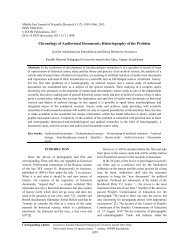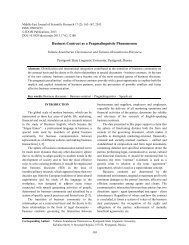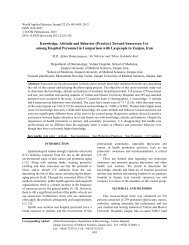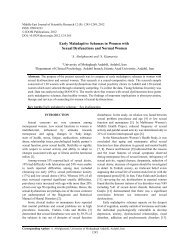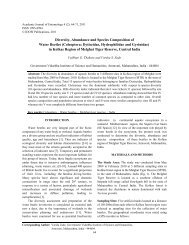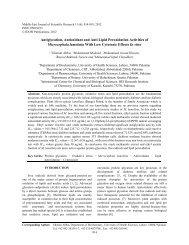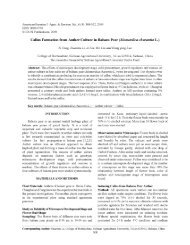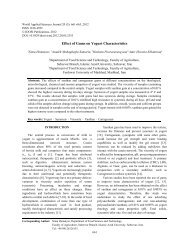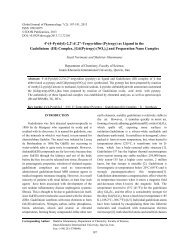Theoretical and Methodological Basis of a Bonus System ... - Idosi.org
Theoretical and Methodological Basis of a Bonus System ... - Idosi.org
Theoretical and Methodological Basis of a Bonus System ... - Idosi.org
You also want an ePaper? Increase the reach of your titles
YUMPU automatically turns print PDFs into web optimized ePapers that Google loves.
World Applied Sciences Journal 25 (6): 950-955, 2013<br />
ISSN 1818-4952<br />
© IDOSI Publications, 2013<br />
DOI: 10.5829/idosi.wasj.2013.25.06.7067<br />
<strong>Theoretical</strong> <strong>and</strong> <strong>Methodological</strong> <strong>Basis</strong> <strong>of</strong> a <strong>Bonus</strong><br />
<strong>System</strong> at the Industrial Enterprise<br />
1 2<br />
Snitko Ludmila Tarasovna <strong>and</strong> Akimova Galina Zakharovna<br />
1<br />
Belgorod Cooperative University, economics <strong>and</strong> law, Russia, 308023,<br />
Belgorod, Sadovaya street-116,<br />
2<br />
Belgorod State Technological University named after V.G. Shukhov, Russia,<br />
308012, Belgorod, Kostyukova street, 46<br />
Submitted: Sep 2, 2013; Accepted: Oct 9, 2013; Published: Oct 12, 2013<br />
Abstract: In the article the necessity <strong>of</strong> the development <strong>of</strong> theoretical-methodological bases <strong>of</strong> construction<br />
<strong>of</strong> a bonus system at the industrial enterprise; structural elements <strong>of</strong> a bonus system are required; <strong>and</strong><br />
requirements to be fulfilled system <strong>of</strong> bonuses are formulated.<br />
Key words: Motivation Incentive system Performance bonuses The frequency <strong>of</strong> bonuses Motivating<br />
<strong>and</strong> demotivating factors<br />
INTRODUCTION<br />
Personnel motivation as a branch <strong>of</strong> scientific<br />
activity requires the improvement <strong>of</strong> the<br />
In the basis <strong>of</strong> human behavior is a complex <strong>of</strong> methodology <strong>and</strong> development <strong>of</strong> techniques,<br />
motives <strong>and</strong> incentives that determine the choice <strong>of</strong> methods, tools, which help intensification <strong>of</strong> labor<br />
effective or ineffective action. It is important that the activity, to achieve the maximum possible use <strong>of</strong> labor<br />
same stimulus (external stimulus) do not become a cause potential.<br />
for all [1, 2, 3]. The task <strong>of</strong> the employer-pick a set <strong>of</strong> In the complex <strong>of</strong> issues directly related to the<br />
incentives, able to motivate each employee to effective formation <strong>of</strong> qualitatively new aims <strong>of</strong> workers, the<br />
action. Thus, the creation <strong>of</strong> an effective system <strong>of</strong> crucial role belongs to the improvement <strong>of</strong> payment<br />
stimulation <strong>of</strong> labor is possible only if a detailed study <strong>of</strong> systems, most <strong>of</strong> which provide bonuses to the<br />
the expectations <strong>of</strong> workers from employment [4]. personnel for achieving <strong>of</strong> certain quantitative <strong>and</strong><br />
Radical changes in the economics, in the economic qualitative results <strong>of</strong> operations.<br />
mechanism <strong>of</strong> enterprise, formation <strong>of</strong> a socially-oriented We believe that there is a need to develop common<br />
market economy objectively require the improvement requirements for building provisions on bonuses,<br />
<strong>of</strong> the system <strong>of</strong> socio-labor relations <strong>and</strong> raise the which should be developed specific incentive systems<br />
effectiveness <strong>of</strong> work <strong>and</strong> production in all sectors <strong>of</strong> at each enterprise [5].<br />
the economics.<br />
Today in the world a great experience has<br />
Current state <strong>of</strong> the economics requires the accumulated in formation <strong>of</strong> payment systems,<br />
activation <strong>of</strong> the human factor, development <strong>of</strong> creative the use <strong>of</strong> which could <strong>and</strong> Russian enterprises,<br />
potential <strong>of</strong> employees that can be achieved through taking into account the specifics <strong>of</strong> our legislation<br />
the involvement <strong>of</strong> the whole arsenal <strong>of</strong> methods <strong>of</strong> [6-10]. However, it is necessary to note the lack<br />
improvement <strong>of</strong> material <strong>and</strong> non-material motivation <strong>of</strong> elaboration <strong>of</strong> scientific-methodological <strong>and</strong><br />
<strong>of</strong> labor activity.<br />
theoretical principles <strong>of</strong> construction <strong>of</strong> modern<br />
systems <strong>of</strong> wages. The criticism <strong>of</strong> the current practice<br />
The Main Part: The complexity <strong>of</strong> the scientific work <strong>and</strong> <strong>of</strong> the <strong>org</strong>anization <strong>of</strong> wages or reference to the<br />
the justification <strong>of</strong> practical recommendations in the field international experience is prevailed, without pro<strong>of</strong> <strong>of</strong> the<br />
<strong>of</strong> motivation <strong>of</strong> labor activity is multi-faceted problem, possibility <strong>and</strong> expediency <strong>of</strong> its use in the national<br />
its connection with the findings <strong>of</strong> many sciences. practice.<br />
Corresponding Author: Snitko Ludmila Tarasovna, Belgorod Cooperative University, economics <strong>and</strong> law, Russia,<br />
308023, Belgorod, Sadovaya street-116.<br />
950
World Appl. Sci. J., 25 (6): 950-955, 2013<br />
Table 1: Possible variants <strong>of</strong> the decision <strong>of</strong> industrial problems, associated with changes in the remuneration system<br />
Production task<br />
Possible solutions<br />
Saving <strong>of</strong> the salary Fund<br />
-Payment <strong>of</strong> large premiums instead <strong>of</strong> the annual increase in salaries<br />
-The division among employees regarding saving <strong>of</strong> the salary fund,<br />
received as a result <strong>of</strong> productivity growth<br />
Increasing the efficiency <strong>of</strong> production<br />
-The individualization <strong>of</strong> salary<br />
- Distribution <strong>of</strong> collective earnings<br />
- Skill premium <strong>and</strong> knowledge<br />
- Distribution <strong>of</strong> pr<strong>of</strong>its, provided the direct involvement <strong>of</strong><br />
staff in management<br />
Improvement <strong>of</strong> the discipline <strong>and</strong> commitment <strong>of</strong> employees<br />
-Supplements for lack <strong>of</strong> absenteeism <strong>and</strong> lateness<br />
-Improving the exchange <strong>of</strong> information between different levels <strong>of</strong> governance<br />
-Recognition <strong>of</strong> merits employee<br />
Reducing the difference between workers <strong>of</strong> different levels <strong>of</strong> management -Transfer on the salaries <strong>of</strong> all workers<br />
-Reduction <strong>of</strong> salary executives<br />
The stimulation <strong>of</strong> innovation<br />
Creation <strong>of</strong> award funds for innovations<br />
Aims <strong>and</strong> developed tasks include the selection <strong>of</strong> The basics <strong>of</strong> using the motivating potential<br />
the optimal solution through modifying <strong>and</strong> combining conditions <strong>and</strong> performance bonuses are following.<br />
the various elements <strong>of</strong> motivation. We think that the In general terms the conditions are those indicators,<br />
industrial enterprises in various production tasks can be achievement <strong>of</strong> which only provides a basis for premium<br />
solved by the use <strong>of</strong> different variants <strong>of</strong> payment payment. The size <strong>of</strong> the premium must depend on the<br />
systems (Table 1).<br />
performance bonuses, i.e. from the level <strong>of</strong> dynamics etc.<br />
In the criterion <strong>of</strong> efficiency <strong>of</strong> one or another Conditions <strong>and</strong> performance bonuses advisable<br />
system <strong>of</strong> bonuses should underline the actual interest may separate into basic <strong>and</strong> additional. The main are<br />
<strong>of</strong> the employees in achieving as much as possible the considered indicators <strong>and</strong> conditions, the achievement<br />
individual <strong>and</strong> collective labor results, all the better use <strong>of</strong> which is crucial for solving the problems facing the<br />
<strong>of</strong> their creative potential. A reflection <strong>of</strong> real interest, collective or the individual employee. Additional<br />
i.e. its manifestation, the implementation in practice is indicators <strong>and</strong> terms <strong>of</strong> bonuses should stimulate other,<br />
the achievement <strong>of</strong> the strategic <strong>and</strong> tactical goals, less important, aspects <strong>of</strong> employment.<br />
individual members <strong>of</strong> the collective <strong>and</strong> the enterprise. Fulfilments <strong>of</strong> conditions bonuses based on their<br />
Among these aims-is the achievement <strong>of</strong> desired results nature <strong>and</strong> purpose, is not a basis for increasing the size<br />
<strong>of</strong> individual <strong>and</strong> remuneration for the services <strong>of</strong> labor, <strong>of</strong> remuneration. In case <strong>of</strong> failure <strong>of</strong> the main conditions<br />
pr<strong>of</strong>it maximization, expansion <strong>of</strong> markets, increasing <strong>of</strong> <strong>of</strong> the bonus prize is impractical to pay in case <strong>of</strong> failure<br />
competitiveness <strong>of</strong> production etc.<br />
only additional conditions <strong>of</strong> the award may be reduced<br />
The obligatory components <strong>of</strong> any bonus system (up to 50%).<br />
must be:<br />
In case <strong>of</strong> over-fulfilment <strong>of</strong> both core <strong>and</strong><br />
additional indicators <strong>of</strong> the size <strong>of</strong> the prize is to be<br />
Performance bonuses <strong>and</strong> conditions;<br />
increased. In case <strong>of</strong> failure <strong>of</strong> the main indicators <strong>of</strong> the<br />
The size <strong>of</strong> premiums;<br />
premium is not paid; non-additional-is the basis to<br />
Sources <strong>of</strong> payment <strong>of</strong> premiums;<br />
reduce the remuneration.<br />
Categories <strong>of</strong> personnel to be awarding;<br />
Need to take a responsible <strong>and</strong> balanced approach<br />
Periodicity <strong>of</strong> bonuses;<br />
to the choice <strong>of</strong> specific indicators <strong>and</strong> conditions<br />
Procedure for the payment <strong>of</strong> premiums.<br />
bonuses. First <strong>of</strong> all, the main requirement that indicators<br />
<strong>and</strong> conditions should meet the goals <strong>of</strong> the team <strong>and</strong> a<br />
We believe that to ensure effective impact on the specific performer <strong>and</strong>, secondly, really depended on the<br />
behavior <strong>of</strong> the staff through material incentives is labour effort <strong>of</strong> a particular group or a particular employee.<br />
possible only subject to a number <strong>of</strong> specific requirements The existence <strong>of</strong> specific bottlenecks in<br />
for the development <strong>of</strong> a system <strong>of</strong> bonuses.<br />
production leads to the direction <strong>of</strong> the efforts <strong>of</strong><br />
First <strong>of</strong> all, the bonus system, which must include individual performers <strong>and</strong> the entire team on improving<br />
both indicators <strong>and</strong> terms <strong>of</strong> bonuses, it is fundamentally the state <strong>of</strong> affairs in a particular sphere <strong>of</strong> production<br />
important to distribute the load between them. activities. It is important to ensure diversification<br />
951
World Appl. Sci. J., 25 (6): 950-955, 2013<br />
indicators <strong>and</strong> conditions bonuses, bind them to the Share <strong>of</strong> production <strong>of</strong> the enterprise in the total<br />
tasks <strong>of</strong> departments <strong>and</strong> functional responsibilities <strong>of</strong> volume <strong>of</strong> the market <strong>of</strong> same production; business<br />
the performers.<br />
activity <strong>of</strong> the enterprise.<br />
We suppose that the bottleneck in the production<br />
is the execution <strong>of</strong> contractual obligations on delivery <strong>of</strong> The Indicators <strong>of</strong> the Second Group Should Include:<br />
products. For workers <strong>of</strong> the higher <strong>and</strong> middle managers,<br />
who are primarily responsible for the performance <strong>of</strong> Indicators <strong>of</strong> solvency <strong>and</strong> financial stability <strong>of</strong><br />
contractual obligations, an indicator <strong>of</strong> the condition <strong>of</strong> the enterprise (the liquidity coverage ratio, a measure<br />
bonuses may be the execution <strong>of</strong> obligations on deliveries <strong>of</strong> the overall solvency, financial independence ratio,<br />
<strong>of</strong> products under the contracts concluded in the whole the ratio between the borrowed <strong>and</strong> own funds <strong>of</strong><br />
enterprise. However, if this indicator is the bottleneck the enterprise);<br />
in the activities <strong>of</strong> the enterprise, so, to improve the state Indicatorf competitiveness <strong>of</strong> production <strong>of</strong> the<br />
<strong>of</strong> affairs in this direction can be provided gain interest enterprise (the share <strong>of</strong> exports in total production,<br />
in realization <strong>of</strong> the plans <strong>of</strong> supply on the contracts the share <strong>of</strong> certified products, the ratio between<br />
<strong>of</strong> workers, specialists, employees <strong>of</strong> the departments. the prices on the same production company <strong>and</strong><br />
The bonus system <strong>of</strong> the specified categories <strong>of</strong> competitors);<br />
personnel should include indicators <strong>and</strong> conditions, as<br />
output prescribed item, implementation <strong>of</strong> the schedule The performance <strong>of</strong> the share capital company<br />
<strong>of</strong> delivery <strong>of</strong> goods to the warehouse, production (earnings per share, the ratio between market <strong>and</strong><br />
rhythm. These parameters depend on the labour effort <strong>of</strong> nominal price <strong>of</strong> a share).<br />
the workers, experts <strong>and</strong> employees <strong>and</strong> their achievement It is important that the number <strong>of</strong> indicators <strong>and</strong><br />
provides the performance by the enterprise <strong>of</strong> contractual conditions bonuses was limited. According to research<br />
commitments for the supply <strong>of</strong> products.<br />
on engineering psychology <strong>of</strong> optimal number <strong>of</strong> logical<br />
It should be stressed that the business environment conditions for human activity does not exceed more<br />
inherent to market economics, require major changes in than four. In case their increasing the time dramatically<br />
the composition <strong>of</strong> performance bonuses, the quality <strong>of</strong> increases needed for decision-making, increases the<br />
their diversity compared with those used in the last time. likelihood <strong>of</strong> errors. It is <strong>of</strong> fundamental importance for<br />
As an example, consider the variant <strong>of</strong> performance the choice <strong>of</strong> indicators <strong>and</strong> conditions bonuses-because<br />
bonuses <strong>of</strong> the managers <strong>and</strong> chief specialists <strong>of</strong> the <strong>of</strong> their large number <strong>of</strong> presentation is lost<br />
enterprises, which can be used when building modern communication with the main tasks <strong>of</strong> production <strong>and</strong><br />
systems <strong>of</strong> bonuses.<br />
the main results <strong>of</strong> the activities <strong>of</strong> the team (the worker).<br />
Given that the position <strong>of</strong> the company on the market, Besides the likelihood <strong>of</strong> their failure is increasing,<br />
level <strong>of</strong> economic <strong>and</strong> social development largely depend serving as motivating factor. The optimum is the number<br />
on how successfully the managers <strong>and</strong> chief experts <strong>of</strong> parameters <strong>and</strong> conditions at the level <strong>of</strong> 2-3, the<br />
solve the problems <strong>of</strong> development <strong>of</strong> production <strong>and</strong> maximum-4.<br />
improvement <strong>of</strong> a financial condition <strong>of</strong> the company, It is crucially important that performance bonuses<br />
indicators <strong>of</strong> performance evaluation <strong>and</strong> bonus payments <strong>and</strong> conditions put in the bonus system, do not contradict<br />
to these categories <strong>of</strong> staff it is expedient to reduce each other <strong>and</strong>, consequently, to improvement <strong>of</strong> one<br />
into two groups: indicators <strong>of</strong> an estimation <strong>of</strong> efficiency does not cause deterioration <strong>of</strong> the other. If the<br />
<strong>of</strong> industrial <strong>and</strong> economic activities <strong>and</strong> indicators for contradictions between the two indicators has not<br />
evaluating the effectiveness <strong>of</strong> commercial <strong>and</strong> financial avoided, it should be subject to certain conditions,<br />
activities.<br />
allowing you to negotiate differently directed interests.<br />
For example, a bonus for exceeding the st<strong>and</strong>ards is paid<br />
Among the Indicators <strong>of</strong> the First Group Will Allocate: in case the quality <strong>of</strong> performance. Another option-an<br />
award for the surrender <strong>of</strong> the products with the first<br />
Earnings (in the whole company <strong>and</strong> per employee); view is payable subject to the fulfilment <strong>of</strong> an employee<br />
Increasing <strong>of</strong> production volumes <strong>and</strong> commodity <strong>of</strong> manufacturing jobs in the prescribed range. Other<br />
sales in the current period compared with the variants are possible ranking, coordination <strong>of</strong> conditions<br />
previous periods <strong>of</strong> work <strong>of</strong> the enterprise;<br />
<strong>and</strong> performance bonuses.<br />
952
World Appl. Sci. J., 25 (6): 950-955, 2013<br />
For performance bonuses <strong>and</strong> conditions exerted One solution to this problem is further differentiation<br />
a stimulating effect on the behaviour <strong>of</strong> the personnel <strong>of</strong> the prize, which accrued for the main results,<br />
(individual performers) <strong>and</strong> meet the objectives <strong>of</strong> depending on the indicators characterizing the tension,<br />
their activity, it is necessary to determine the base the intensity <strong>of</strong> labour process. For example, the award <strong>of</strong><br />
(their original value) <strong>and</strong> provide the technology to the worker's collectives (brigades) accrued for fulfilment<br />
determine the actual level <strong>of</strong> performance <strong>and</strong> conditions <strong>of</strong> production (normalized) tasks can be modified later<br />
giving rise to the payment <strong>of</strong> remuneration.<br />
(higher or lower) depending on the indicators <strong>of</strong> the level<br />
Based on the specific objectives production <strong>of</strong> <strong>of</strong> use <strong>of</strong> the equipment <strong>and</strong> delivery <strong>of</strong> products with the<br />
indicators (criteria) <strong>of</strong> bonuses can be:<br />
first view.<br />
The second option is accrued to employees or team<br />
Aimed at maintaining that already achieved bonus for fulfilment <strong>of</strong> production (normalized) jobs varies<br />
(extremely high, acceptable or permissible) level. depending on the fulfilment <strong>of</strong> production norms <strong>and</strong><br />
For example, the fulfilment <strong>of</strong> production targets, quality <strong>of</strong> products <strong>and</strong> volume <strong>of</strong> marriage in percentage<br />
ensuring regulatory quality, the preservation <strong>of</strong> the from the total volume <strong>of</strong> output). Other variants <strong>of</strong> further<br />
achieved level <strong>of</strong> loading equipment <strong>and</strong> etc;<br />
differentiation <strong>of</strong> the award are possible.<br />
An important requirement to the construction <strong>of</strong> a<br />
Are designed to further improve the results <strong>of</strong> bonus system at the enterprise is-it is necessary to<br />
operations-growth (increase) in comparison with the include in the list <strong>of</strong> employees only those, who should be<br />
previous period or corresponding period <strong>of</strong> last year; awarded <strong>and</strong> who can affect already achieved or further<br />
the exceeding <strong>of</strong> the average level <strong>of</strong> production on this; improvement <strong>of</strong> the baseline levels <strong>of</strong> performance<br />
fulfilment <strong>of</strong> production targets etc.<br />
bonuses.<br />
So, for example, the indicator bonus performance In other words, if the employee is unable to change<br />
<strong>of</strong> contractual obligations on deliveries <strong>of</strong> production the situation in a certain area <strong>of</strong> production activity better,<br />
is aimed at one-hundred percent fulfilment <strong>of</strong> the because it does not depend on his efforts <strong>and</strong> the reward<br />
agreements, but no more, because <strong>of</strong> the surpassing it for its performance does not make sense.<br />
contradicts the essence <strong>of</strong> this indicator. However, When designing this component <strong>of</strong> the bonus<br />
indicators such as the growth <strong>of</strong> labour productivity, system, as the frequency <strong>of</strong> bonuses (monthly, quarterly,<br />
quality improvement, cost reduction; growth <strong>of</strong> yield is annual results or lump sum), should take into account<br />
encouraged to continue to improve the impact <strong>of</strong> the peculiarities <strong>of</strong> <strong>org</strong>anization <strong>of</strong> production <strong>and</strong> labour,<br />
activities compared with the estimated level or the the nature <strong>of</strong> performance bonuses, adequate account <strong>of</strong><br />
corresponding period last year.<br />
results <strong>of</strong> activity for a specific period. For example,<br />
The following requirement for the construction <strong>of</strong> employees are rewarded for the current main activity<br />
a bonus system at the enterprise is that it is necessary results, usually monthly. It is this frequency contributes<br />
to provide justification <strong>of</strong> premium. Their aim is to ensure to the motivation <strong>of</strong> the workers <strong>and</strong> it is possible thanks<br />
that the size <strong>of</strong> the promotion <strong>of</strong> the largest labour to the operational integration <strong>of</strong> the results <strong>of</strong> their<br />
contribution <strong>of</strong> the collective or the employee. labour. For managers, specialists <strong>and</strong> employees in the<br />
When solving this problem (<strong>and</strong> this is the main difficulty) appropriate quarterly bonuses, as indicators <strong>and</strong><br />
should take into account many factors: the value <strong>of</strong> a conditions <strong>of</strong> the promotion can be defined most <strong>of</strong>ten<br />
specific indicator for industrial applications, the number on the basis <strong>of</strong> quarterly reporting. However, in the<br />
<strong>of</strong> simultaneously stimulating factors, their source levels shops for these categories <strong>of</strong> staff may be established<br />
<strong>and</strong> the scope for further improvements, complexity <strong>of</strong> monthly period for bonus, based on the primary<br />
a unit increase or achieve a certain level <strong>of</strong> indicators. operational reporting <strong>of</strong> these production units.<br />
Proceeding from the principle <strong>of</strong> equal prize for the At the same time, because <strong>of</strong> too long production<br />
same additional efforts , it can be concluded that the use cycle, the season work when performing intensive works<br />
<strong>of</strong> several indicators bonus large portion <strong>of</strong> the premium with a lump-sum payment <strong>of</strong> labour are possible <strong>and</strong><br />
should be spent on the measure implementation or longer periods <strong>of</strong> activity, the results <strong>of</strong> which is accrued<br />
improvement which requires large efforts. Moreover, to the prize.<br />
enhance the motivating potential bonus system must In addition to above requirements for the<br />
take into account the tension <strong>of</strong> parameters <strong>and</strong> development <strong>of</strong> premium provisions <strong>of</strong> the motivating<br />
conditions for achievement <strong>of</strong> which fee shall be paid. type, you must also consider the following:<br />
953
World Appl. Sci. J., 25 (6): 950-955, 2013<br />
Prize should not be awarded for activities, which is It is important that performance bonuses <strong>and</strong><br />
m<strong>and</strong>atory <strong>and</strong> payable to the permanent (tariff) part<br />
<strong>of</strong> the salary;<br />
Cannot be recognized expedient paying a premium<br />
for reasons do not related with work, but, in<br />
connection with his retirement, unsatisfactory<br />
financial situation, etc;<br />
Insignificant in size, but broad coverage <strong>of</strong> workers<br />
<strong>and</strong> frequent bonuses turns into a stable form <strong>of</strong><br />
payment <strong>and</strong> is not a factor-motivator.<br />
CONCLUSION<br />
The prize is more flexible <strong>and</strong> mobile, in comparison<br />
with salaries, financial incentives. Therefore, the bonus<br />
system must take into account the specifics, peculiarities<br />
<strong>of</strong> work <strong>of</strong> the enterprise <strong>and</strong> timely react to all changes<br />
in production. Consideration <strong>of</strong> these factors <strong>and</strong><br />
ensuring the efficiency <strong>of</strong> the system <strong>of</strong> material<br />
incentives requires constant improvement. However,<br />
analysis <strong>of</strong> existing systems <strong>of</strong> bonuses showed that<br />
many authors in a one-sided approach to the decision <strong>of</strong><br />
this problem, considering only the individual elements <strong>of</strong><br />
premium systems, the plurality <strong>of</strong> conditions bonuses<br />
greatly complicates the bonus system, to deprive the<br />
workers <strong>of</strong> the award, which reduces the stimulating<br />
effect <strong>of</strong> the award.<br />
This implies a need to improve work incentives<br />
<strong>and</strong> search <strong>of</strong> new methodological approaches to the<br />
construction <strong>of</strong> bonus systems that allow to take into<br />
account the nature, complexity <strong>and</strong> production<br />
significance <strong>of</strong> the performed work, contributing to the<br />
growth <strong>of</strong> the employees ' interest in improving education<br />
<strong>and</strong> pr<strong>of</strong>essional skills, the results <strong>of</strong> individual work<br />
<strong>and</strong> work <strong>of</strong> personnel <strong>of</strong> the enterprise as a whole.<br />
conditions really depended on the labour effort <strong>of</strong> a<br />
particular group or a particular employee. For managers<br />
<strong>and</strong> senior staff it should be divided into indicators <strong>of</strong><br />
an estimation <strong>of</strong> efficiency <strong>of</strong> industrial <strong>and</strong> economic<br />
activities <strong>and</strong> indicators <strong>of</strong> evaluating the effectiveness<br />
<strong>of</strong> commercial <strong>and</strong> financial activities.<br />
Performance bonuses <strong>and</strong> conditions should not<br />
contradict to each other <strong>and</strong> their number should be<br />
limited. With the goal <strong>of</strong> strengthening the stimulating<br />
effects need to determine the base <strong>and</strong> provide the<br />
technology <strong>of</strong> determining the actual level <strong>of</strong> performance<br />
<strong>and</strong> conditions which give a rise to the payment <strong>of</strong><br />
remuneration.<br />
The following requirement for the construction <strong>of</strong> a<br />
bonus system at the enterprise is necessary to provide<br />
justification <strong>of</strong> premium <strong>and</strong> consider the tensions <strong>of</strong><br />
parameters <strong>and</strong> conditions for achievement <strong>of</strong> which fee<br />
shall be paid.<br />
In the composition <strong>of</strong> workers, which should reward<br />
must include only those who can affect to the<br />
improvement <strong>of</strong> the baseline to directly levels <strong>of</strong><br />
performance bonuses.<br />
When you design a premium system, you must<br />
consider its component such as frequency <strong>of</strong> bonuses<br />
(monthly, quarterly, annual results or as a lump sum),<br />
based on the characteristics <strong>of</strong> the <strong>org</strong>anization <strong>of</strong><br />
production <strong>and</strong> labour.<br />
Building a bonus system at the enterprise <strong>and</strong><br />
taking into account the listed requirements will increase<br />
its motivational potential, growth <strong>of</strong> labour activity <strong>of</strong><br />
the personnel, the achievement as individual goals <strong>of</strong><br />
each employee <strong>and</strong> as goals <strong>of</strong> the enterprise.<br />
REFERENCE<br />
Conclusions: Personnel motivation requires improvement<br />
<strong>of</strong> the methodology <strong>and</strong> development <strong>of</strong> techniques,<br />
methods, tools, which help intensification <strong>of</strong> labour<br />
activity.<br />
It is necessary to develop the general requirements<br />
for building a system <strong>of</strong> bonuses, which realization will<br />
allow solving various production tasks at the enterprises<br />
<strong>of</strong> the industry through the use <strong>of</strong> different options<br />
remuneration systems.<br />
First <strong>of</strong> all, obligatory components <strong>of</strong> the bonus<br />
system should be defined (performance bonuses <strong>and</strong><br />
conditions; the size <strong>of</strong> prizes; the sources <strong>of</strong> their<br />
payments, categories <strong>of</strong> personnel to be awarding; the<br />
frequency <strong>of</strong> bonuses; procedure <strong>of</strong> payment <strong>of</strong><br />
premiums).<br />
1. Maslou, A., 2008. Motivation <strong>and</strong> personality.<br />
St. Petersburg, pp: 352.<br />
2. Volgin, N.A., 2004. Work payment : production,<br />
social sphere, the state service (analysis, problems,<br />
solutions) M: Publishing house Examination ,<br />
pp: 224.<br />
3. Slesinger, G.A., 2006. Work in conditions <strong>of</strong><br />
market economy. M: INFRA-M, pp: 336.<br />
4. Speransky, A.A. <strong>and</strong> N.V. Dragunkina, 2006.<br />
Optimization <strong>of</strong> the system <strong>of</strong> remuneration <strong>and</strong><br />
material incentives. M: Publishing house <strong>of</strong><br />
Alfa-Press, pp: 192.<br />
5. Snitko, L.T., 2010. <strong>Theoretical</strong> bases <strong>of</strong> the system<br />
<strong>of</strong> bonuses. // The Bulletin <strong>of</strong> the Belgorod<br />
University <strong>of</strong> Cooperation, economics <strong>and</strong> law,<br />
1: 12-16.<br />
954
World Appl. Sci. J., 25 (6): 950-955, 2013<br />
6. Stefan Bender, Julia Lane, Kathryn Shaw, 8. Craig C. Pinder, 2008. Work Motivation in<br />
Fredrik Andersson <strong>and</strong> Till Von Wachter, 2008. Organizational Behavior. Second Edition.<br />
The Analysis <strong>of</strong> Firms <strong>and</strong> Employees: Quantitative Psychology Press, pp: 356.<br />
<strong>and</strong> Qualitative Approaches. University <strong>of</strong> Chicago 9. Gary P. Latham, 2011. Work Motivation: History,<br />
Press, pp: 386.<br />
Theory, Research <strong>and</strong> Practice. SAGE Publications,<br />
7. Frederick Herzberg, Bernard Mausner <strong>and</strong> Inc.; Second Edition., pp: 456.<br />
Barbara Bloch Snyderman, 1993. The Motivation to 10. Bob Hart, 2010. The Economics <strong>of</strong> Non-Wage Labour<br />
Work, Transaction Publishers. Reprint edition, Costs (Routledge Revivals). Routledge ; 1 edition,<br />
pp: 180. pp: 192.<br />
955



